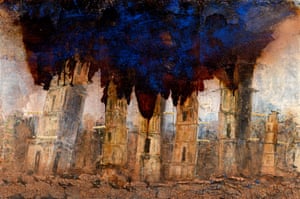Kiefer’s warnings about the frailty of society now look scarily prescient, and his Wagnerian new works suggest the innate violence of nationalism.
When critics feel like taking a pop at the spectacularly serious art of Anselm Kiefer, they tend to moan that he is a little bit melodramatic. Throughout his career in a peaceful, affluent, liberal post-1945 Europe, he has wallowed in nightmares from history. His art is loaded with the past, caked with the mud of battles, clogged with ashes of the murdered. He has even posed making a Nazi salute, as if addicted to horrors that some think would be better forgotten. Isn’t it all a bit de trop?
et with his awe-inspiring new exhibition, Kiefer’s time has come, and not in an agreeable way. He told us history was a nightmare. He tried to show that reason has rarely ruled the world. His art has been one long warning that liberal democracy is a frail moment of light surrounded by forests of shadow and evil. Who can say Kiefer’s grave and haunted vision of history as a mad ride on a ghost train is overstated, now that we see the demons of nationalism and racism on the rise?
You walk into the White Cube gallery in south London and, instead of its usual eponymous whiteness, you are plunged into a sepulchral metallic cavern where hospital beds with lead blankets and pillows are lined up as if in the last days of a world war. Rusty machine guns rest on some of the beds. It is like Hitler’s bunker or a drowned U-boat. It is also like a set for Wagner’s Götterdämmerung, and that is the explicit theme of this exhibition, which is called Walhalla, and mourns the final destruction of the Norse and German pagan pantheon of gods and heroes. One of the beds is marked Brünnhilde, and at the end of this gallery of the fallen, a solder walks away in a blown-up photograph, recalling the Somme yet also resembling a famous photograph of Kiefer’s master Joseph Beuys. But where Beuys marched forward, believing in the future, planting trees, this figure is walking away, into the past, a departing ghost.
In drawing on myth, Kiefer revisits the ways myth has been abused in modern history. In a leaden tomb-like chamber, a German eagle lies on a sickbed. Its wings are immense but its body is an immovable rock. This is the tomb of nationalist folly: an eagle doomed to crash.

In that crash, millions may suffer. They have suffered. Empty clothes, caked with the muck of time, hang from a rusty spiral staircase in another chamber, the clothes of women, men and children caught up in history’s storm. A devastated city of bombed towers, a recurring image in Kiefer’s art, becomes a memory of German cities in 1945 (the year Kiefer was born), an image of Aleppo now, and an intimation of apocalypse.
On one massive painting, the names of German artists are scrawled, including that of Albrecht Dürer. Ever since Dürer created his series of woodcuts of the apocalypse in 1498, German artists have had no problem imaging the end of the world. Kiefer does more than imagine it. He takes you there, in an installation that is gleefully, monstrously theatrical and at the same time subtle, rich, poetic. The long nightmare corridor of hospital beds leads to more rooms that include an eerie archival chamber loaded with decaying documents. Here and elsewhere, rusted, rotten, bullet-holed wheelchairs, beds and stretchers look like second world war salvage. For every Wagnerian reference there is a corresponding reminder of where such grandiosity leads. One sculpture represents the Ride of the Valkyries as a pile of rusty bicycles that look as if they might have been used by soldiers trying to escape the eastern front, and dug up in a field strewn with bones.

You could find this exhibition gripping purely as a vast piece of installation art, but ultimately all its drama is just an introduction to Kiefer’s paintings. These are themselves so weighted with the stuff of the world that they seep out into three-dimensional space. Molten-lead gas been poured on to them, as well as Kiefer’s more conventional materials such as broken glass and dried plants.
Explosions of lead and eerie light burst forth above painted fields whose ploughed furrows reach away in vast perspectives. There is a brilliant convulsive tension between the pictured landscapes and their tangled, embattled, chaotic surfaces. I could look at these paintings for hours. Splurts of bright red and pink make you see and feel flowers in the fields, even as the poisoned sky shudders with violence. Nature collides with history. This is the great art of our terrifying time.
• Anselm Kiefer: Walhalla is at White Cube Bermondsey, London, from 23 November to 12 February.
Thank you
Your crucial financial support makes our journalism possible. We do it because we believe, like you, that the world has never needed fearless, independent media more.




























